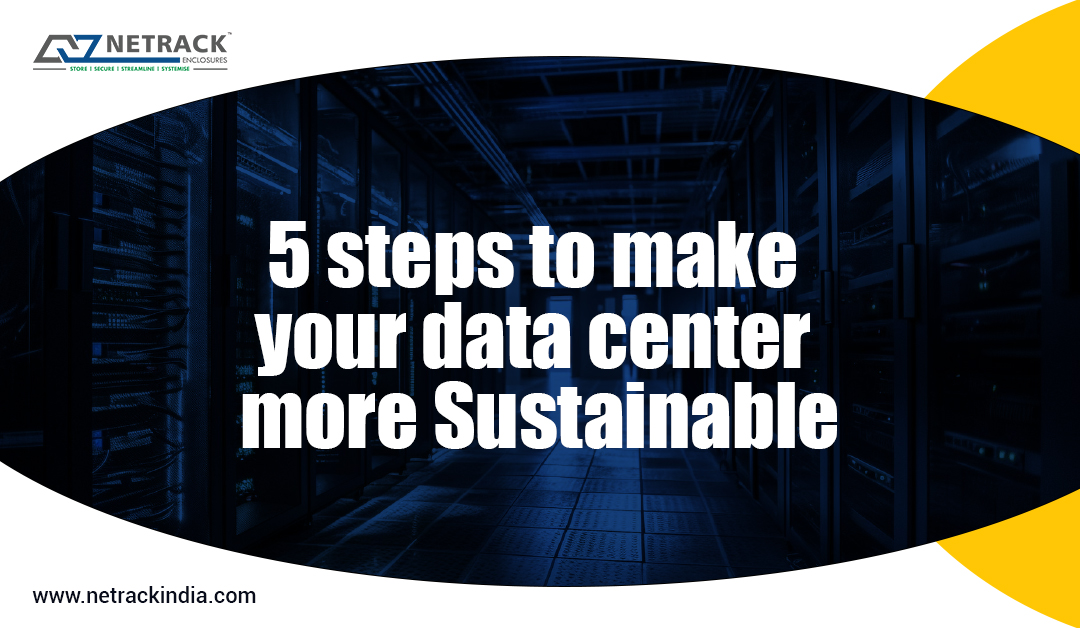
5 steps to make your data center more Sustainable
Over the last few years, continuous efforts have been made to enhance the efficiency of data centers. It is no longer only an environmental responsibility to make a data center more sustainable but also to cut operational costs, comply with regulations, improve brand reputation, and ensure long-term viability in an increasingly environmentally conscious world. Now, the first step to embracing sustainability initiatives for a data center is to choose the right rack and accessories.
The power of choosing the right rack
Choosing the right rack and accessories is crucial for making a data center more sustainable because the layout and design of racks can significantly impact airflow within the data center. Sustainable data centers aim to reduce energy consumption. Energy-efficient racks and accessories can contribute to this goal by optimizing airflow, reducing cooling needs, and accommodating energy-efficient IT equipment. They also play a role in ensuring that power distribution and monitoring are efficient and effective.
Racks designed for efficient airflow management reduce the need for excessive cooling, lowering energy consumption and operating costs. Racks and accessories like server rack blanking panels and brush modules also prevent building up hot spots within the data center. When racks are designed with cooling efficiency in mind, it reduces the workload on cooling systems and enhances their overall efficiency. Choosing high-quality racks and accessories ensures they will have a longer lifespan, reducing the need for frequent replacements. Also, the right rack and accessories provide scalability and adaptability. This flexibility reduces waste and supports long-term sustainability.
Cooling efficiency at its best
Data centers generate significant heat; if not managed correctly, this heat can lead to equipment failures and increased energy costs. The second step to make data centers more sustainable is implementing hot and cold aisle containment systems to further isolate hot and cold air. This prevents the mixing of air and allows for more efficient cooling. Options include raised floor designs, ceiling panels, and curtains or doors at the ends of aisles.
Hot and cold aisles are often sealed off using physical barriers like doors or curtains to prevent hot and cold air from mixing. This ensures that the cold air is directed where needed and hot air is efficiently removed through ventilation.
Cooling solutions for efficiency and reliability
Proper cooling is the third step to ensure servers and other IT equipment’s reliable and efficient operation. Here, it is necessary to understand that the choice of cooling solution should be tailored to the specific requirements and constraints of the data center, including its size, location, and the type of equipment it houses. For that, it is essential to understand the heat generation and dissipation characteristics of the equipment you’re dealing with. Also, regular assessment and adjustment of the cooling strategy is necessary to adapt to changes in equipment density and technology advancements for an efficient and reliable operation.
Row-based cooling solutions efficiently arrange server racks in rows, preventing hot air from mixing with cold air and improving efficiency. Again, precision air conditioning systems designed specifically for data centers can precisely control temperature and humidity within the data center and are more energy-efficient than traditional HVAC systems.
Active cooling solutions, like fans and pumps, require energy but provide more precise control over temperature. Such cooling solutions are an integral part of Netrack’s offering. Passive cooling solutions like heat sinks and natural convection rely on heat dissipation without additional power consumption. Here, it must be elaborated that well-designed ducting and fans ensure even cool air distribution and efficient heat removal. Also, specific cooling equipment has inbuilt fans with variable speeds adjusted based on temperature and workload. Few data centers also rely upon liquid cooling systems to absorb and transfer heat away from components.
There are also cooling solutions that depend upon heat exchangers. These devices transfer heat between a solid object and a fluid, such as air or liquid. Plate heat exchangers, for example, are standard in HVAC systems and industrial processes.
Boosting sustainability with smart power management
The fourth step is to opt for power monitoring solutions and intelligent PDUs that can enhance data center sustainability by optimizing energy usage, identifying inefficiencies, and enabling proactive management. This will reduce energy consumption, cost savings, and a smaller carbon footprint.
Environment monitoring solution: A conscious choice!
Finally, sustainable cooling solutions aim to reduce energy consumption and environmental impact. Hence, an environmental monitoring solution can enhance data center sustainability by maintaining ideal conditions, reducing energy waste, preventing equipment failures, and improving overall efficiency. It helps ensure a stable and eco-friendly operational environment, contributing to sustainability efforts.




